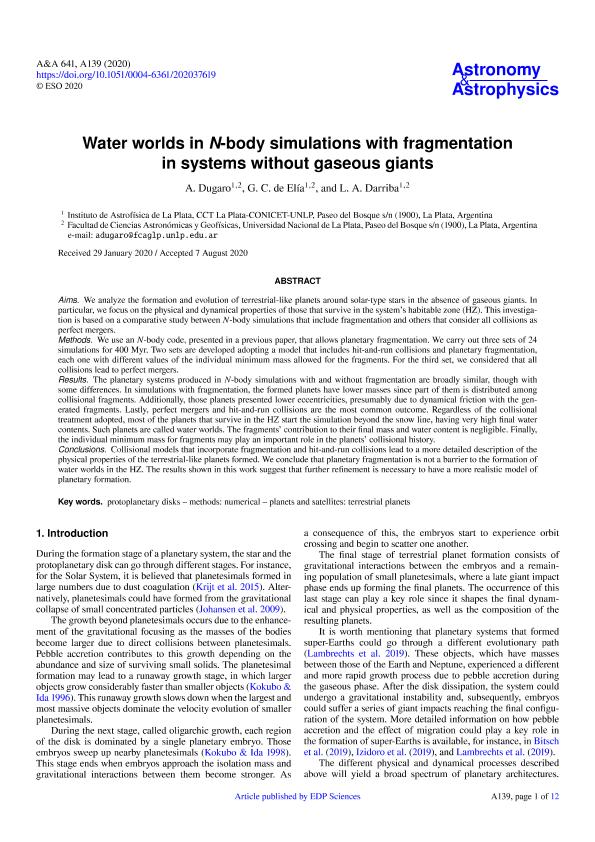Artículo
Water worlds in N-body simulations with fragmentation in systems without gaseous giants
Fecha de publicación:
08/2020
Editorial:
EDP Sciences
Revista:
Astronomy and Astrophysics
ISSN:
0004-6361
Idioma:
Inglés
Tipo de recurso:
Artículo publicado
Clasificación temática:
Resumen
We analyze the formation and evolution of terrestrial-like planets around solar-type stars in the absence of gaseous giants. In particular, we focus on the physical and dynamical properties of those that survive in the system´s Habitable Zone (HZ). This investigation is based on a comparative study between N-body simulations that include fragmentation and others that consider all collisions as perfect mergers.We use an N-body code, presented in a previous paper, that allows planetary fragmentation. We carry out three sets of 24 simulations for 400 Myr. Two sets are developed adopting a model that includes hit-and-run collisions and planetary fragmentation, each one with different values of the individual minimum mass allowed for the fragments. For the third set, we considered that all collisions lead to perfect mergers.The planetary systems produced in N-body simulations with and without fragmentation are broadly similar, with some differences. In simulations with fragmentation, the formed planets have lower masses since part it is distributed amongst collisional fragments. Additionally, those planets presented lower eccentricities, presumably due to dynamical friction with the generated fragments. Lastly, perfect mergers and hit-and-run collisions are the most common outcome.Regardless of the collisional treatment adopted, most of the planets that survive in the HZ start the simulation beyond the snow line, having very high final water contents. Such planets are called water worlds. The fragments´ contribution to their final mass and water content is negligible. Finally, the individual minimum mass for fragments may play an important role in the planets´ collisional history.Collisional models that incorporate fragmentation and hit-and-run collisions lead to a more detailed description of the physical properties of the terrestrial-like planets formed. We conclude that planetary fragmentation is not a barrier to the formation of water worlds in the HZ. The results shown in this work suggest that further refinement is necessary to have a more realistic model of planetary formation.
Archivos asociados
Licencia
Identificadores
Colecciones
Articulos(IALP)
Articulos de INST.DE ASTROFISICA LA PLATA
Articulos de INST.DE ASTROFISICA LA PLATA
Citación
Dugaro, Agustin; de Elia, Gonzalo Carlos; Darriba, Luciano Ariel; Water worlds in N-body simulations with fragmentation in systems without gaseous giants; EDP Sciences; Astronomy and Astrophysics; 641; A139; 8-2020; 1-12
Compartir
Altmétricas




